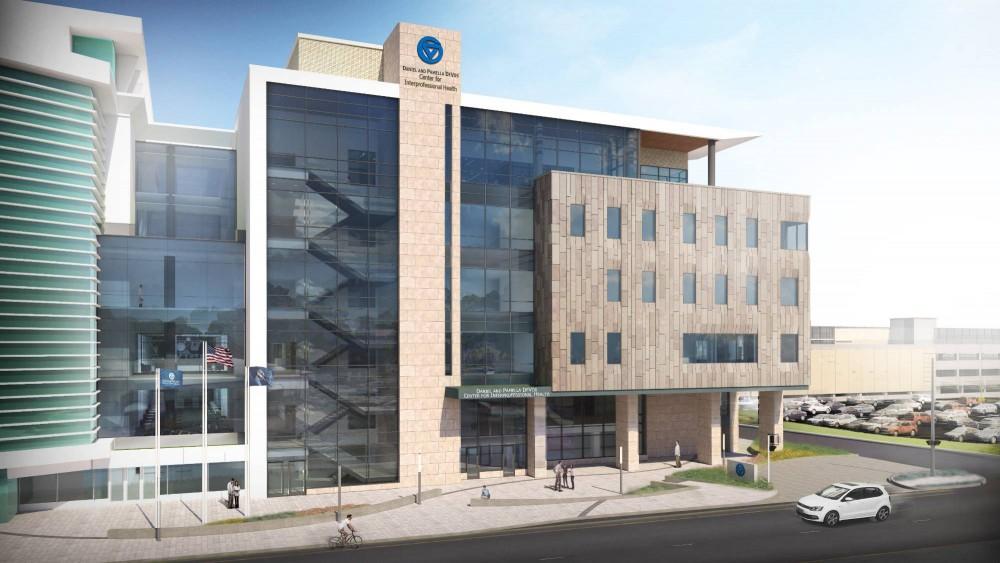GV expands health campus with new building on Medical Mile

Courtesy / gvsu.edu
Oct 29, 2018
Grand Valley State University is continuing to grow its presence in Grand Rapids as it held a groundbreaking ceremony for its newest building on Tuesday, Oct. 23. The Daniel and Pamella DeVos Center for Interprofessional Health will compliment GVSU’s existing Cook-DeVos Health Science Building as well as the recently constructed Finkelstein Hall. The five-story, 160,000 square foot building will serve as an additional anchor to the Medical Mile corridor, illustrating the growing demand for health professionals in the greater Grand Rapids area.
Director of Simulation within the Nursing School Katie Branch sees the new facility as more than just bricks and mortar, but as the new learning opportunities and experiences to be offered within its classrooms.
“The building was designed to be interdisciplinary in nature,” Branch said. “Supporting and inspiring collaborative work among students, faculty, staff. Healthcare is not effectively delivered by professions working in silos. Health-related students learning with, from, and about each other’s professions leads to collaborative practice and safer healthcare.”
Professor of Communication Sciences and Disorders Lee An and Vice Provost for Health Jean Nagelkerk both see the building as a cutting-edge facility that will educate health professionals for years to come.
“The new five-story building will have 15 classrooms, 14 interactive laboratories and state-of-the sciences such as electronic 3D modeling and imaging of the body and its organs,” An said. “These features will create a lot of flexibility, collaboration and interprofessional team environments for student learning.”
Nagelkerk echoed An’s excitement, stating that the new building will provide space designed to promote learning.
“The innovative, state-of-the-art, learning spaces are designed intentionally for shared learning to occur in a simulated healthcare environment,” Nagelkerk said. “The dedicated simulation space in the new building will expand throughout an entire floor providing a variety of learning spaces including a simulated hospital area, ambulatory care space, telehealth area, counseling spaces, skills laboratory practice areas, a virtual anatomy space and a model living area.”
The new building’s location will be just as important as the technology-integrated learning experience. The Medical Mile, located north of downtown Grand Rapids along the sloping Michigan Street corridor, is the largest employment center in west Michigan with over 50,000 nurses, doctors, researchers and students working within the area daily. Institutions such as Ferris State University, Michigan State University, Grand Rapids Community College and others are tapping into the medical district’s resources, working closely with the hospitals that line the street. Coordination between local colleges, hospitals and institutions ensures that the next generation of health professionals practice the hands-on experience so valuable within the medical field.
“Building talent bridges from education to employment is an important aspect of a student’s learning experiences as they develop their skills as a health professional,” Nagelkerk said. “The healthcare systems and organizations in our local area, region and state provide clinical experiences for our students. In addition, students have the opportunity to work part time in many different roles as they complete their educational program.”
Examples of part time opportunities include working as a scribe, nurse technician or certified nurse assistant.
The influx of health professionals and students to the area has prompted both GVSU and the city of Grand Rapids to develop strategies to mitigate traffic within the corridor. Started in August, The Rapid route 19 runs the entire stretch of Michigan Street, connecting GVSU’s new medical campus to Bridge Street Market on the city’s west side. The Laker Line, which will replace Rapid route 50, will provide faster service between the medical center and Allendale.
Director of Construction Shannon Sullivan hopes that students take the bus as not only does it reduce traffic, but it saves students the hassle of driving and parking in an already-congested area.
“There are many benefits for students to ride the bus between campuses,” Sullivan said. “A few of them are avoiding parking tickets, getting homework done or catching up on reading on the bus, avoiding the hunt for parking and saving money on gas.”
The new building represents the growing presence of GVSU’s medical program, as new programs and degrees can be offered with the addition of the facility’s state-of-the-art laboratories and classrooms.
“Prior to the opening of the Cook-DeVos Center for Health Sciences (CHS) in 2003, our health professions programs were located across the Allendale and Grand Rapids campuses,” Nagelkerk said. “Since the opening of CHS, the College of Health Professions has grown from seven programs to seventeen programs.”
GVSU’s investment in the health sciences field shows its dedication to students as well as the greater Grand Rapids region. As students exit the classroom and enter the workforce, they will take lessons learned in the new DeVos Center for Interprofessional Health and apply them within their fields, ensuring that the skills acquired in school are coupled with the best practices within the profession.

























